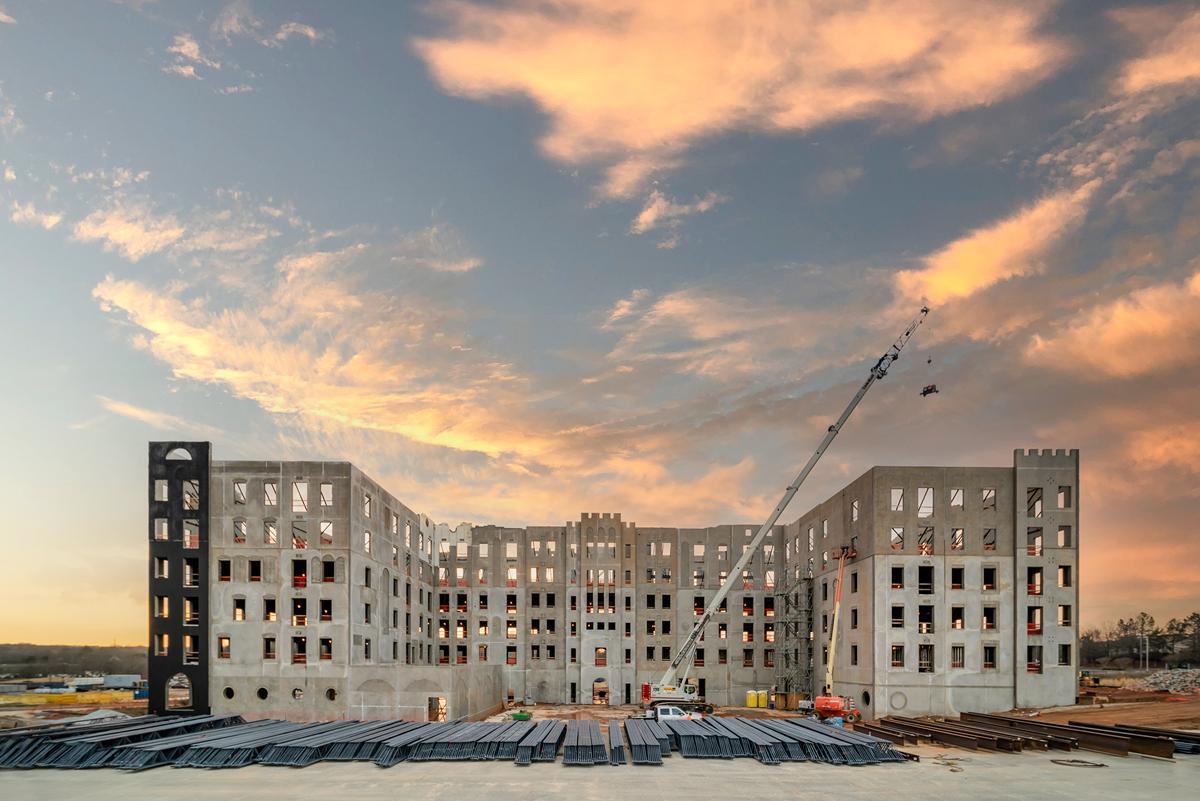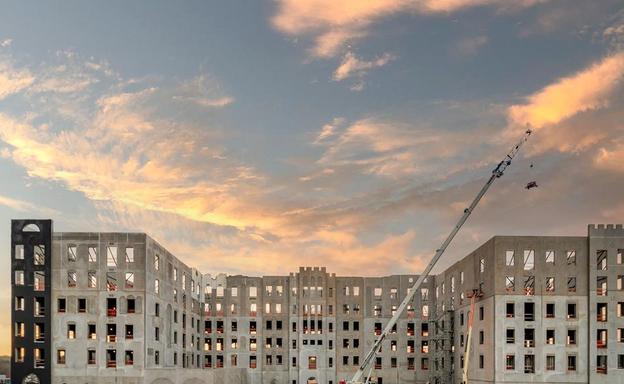Bridgeway Station Block A
Summarize the project's program, features, and achievements: Bridgeway Station Block A is a six-story, mixed-use building that features over 37,000 SF of retail space on the first floor and 163 apartment units above for a total of 209,108 SF. The project was delivered using a Design-Build approach and tilt-up wall panels drove the design. This project was the first six-story tilt-up construction project in South Carolina. The building is partially clad with a mix of original brick and stone exhibiting the look and feel of walking through an Italian village. Block A broke ground in April 2021 and was completed in March 2023, valuing just over $32.7MM. Features: The design of Bridgeway Station is inspired heavily by Italian architecture and features many original Italian artifacts, materials, and inspired elements throughout. With a 'backbone' of strong tilt-wall panels, the building has 'intentionally imperfect' masonry mixed in with arched windows and doorways to give an authentic old-world style to a new building. Given the flexibility of using tilt panels, our team could manipulate the exterior façade to incorporate various materials, including stone, brick, slather, and more. The goal of the building is to have an old and historic feel and be a 100-year structure for future generations to enjoy. Design details that were incorporated into the building were imported Italian relics such as manholes, fountains, crests, and hand-chiseled stone decorations as well as reclaimed mill brick sourced from North Carolina, and regionally-sourced natural stone. Team Building: As a Design-Build project, we had the freedom to select the right design and construction professionals to tackle this challenging project. All the benefits of the Design-Build method were utilized to their fullest. Trade partners were brought in early to work at the same table with the design team to create a detailed model of the project and work through constructability and cost issues. Small-shop old-world craftsman were shored up with larger masonry outfits to provide the historic Italian look on a grand scale. Means and methods were also thought through ahead of time to ensure a smooth process for forming of various deep reveals, radiuses, and formliner installation through the 16” and 10” thick panels. Technologies: Harper utilized our industry-leading, in-house Building Information Modeling (BIM) team during this project to provide value to our client and project partners. We used BIM to locate the casting beds, coordinate building design, map out underground utilities, and data capture for project completion. All these elements resulted in saving time and costly rework for the project. Achievements: This was the first 6-story tilt-up panel building completed in South Carolina. It was completed on a very high-profile site, viewable from the I-385 interstate heading into downtown Greenville. Many of the companies working on this project, along with the owner, took the opportunity to promote the uniqueness of the design, construction methods, and materials that were used. Bridgeway Station has been heavily covered in the media for its elements and tells a unique story of the versatility of tilt-up construction.
What obstacles were overcome related to the schedule, budget, program, specification, site, etc. on this project? We started this project in 2020, while many necessary materials saw major pricing skyrocketing, meaning we needed to buy immediately. We worked to provide storage alternatives and dehumidifier systems to the warehouses to make sure materials did not suffer from long storage times. Another initial obstacle was how to erect tilt-up panels over 88’ tall. The team decided to build a four-story structure of 16” thick load-bearing tilt-up panels with a conventional steel frame with joist and deck supporting elevated concrete slabs. We brought in a 388-ton crane with a VPC-MAX counterweight to handle the 183.5-ton panel weight, which we braced to the outside until the elevated slabs were poured to lock in panels. As elevated deck construction was underway, we cast the panels for the 5th and 6th floors. We set these 10” panels on top of the four-story panels and braced to the 5th-floor slab and the final elevated deck and roof deck construction was completed. When erecting panels, the crane cannot erect on a slope greater than 1%, and this site has a 9% cross slope. To overcome this, we cut benches into the existing grade to provide the 1% maximum slope for the crane. We coordinated the benches in advance with the layout of surrounding casting beds, bracing plan, and allowable crane reach. Site grades created a “basement” condition on the rear of the building, creating the opportunity to use tilt panels as retaining walls, which was coordinated with the engineering team.
Please communicate any engineering complexities or unique features of the panel design for this project. ? The team of Britt, Peters & Associates for structural design and LJB for tilt-up panel design proved to be the perfect team to take on the engineering challenges associated with this project. Several structural systems were vetted early on for cost-effectiveness before we selected tilt-up and a conventional steel frame. Tilt-up and a thickened foundation gave the owner the cost-effective “canvas” he desired to apply the vintage masonry as directed in the field. The weight of this structure was significant, so rammed aggregate piers were deployed to support the foundation system. LJB and BPA took advantage of all the benefits of tilt-up by using the panels for sheer and retaining wall applications. Tilt-up panels were also used to create the elevator and stair shafts because of the fire rating they provide. The structural team designed the frame to allow us to temporarily brace the 5th and 6th-floor panels back to the 4th-floor elevated slab. Due to existing site constraints, the grade needed to vary across the building pad. Autodesk’s BIM360 platform proved to be a valuable real-time collaboration tool for the design team as the grade change challenges required close coordination of utilities entering the building, varied tenant space finish floor elevations, door thresholds & window sills, footing steps, and bottom of tilt wall elevations.
What is the potential for this project's impact on the community and/or environment? Community Impact: Bridgeway Station Block A is a part of a larger, unique development that will bring a new mixed-use downtown to Mauldin, SC. The first phase provides over 400,000 SF of residential, institutional development, office, and 8 space to the Greenville County community. Future adjacent land is available for an additional 11 blocks of growth. Many of the spaces will house local residents and businesses and contribute to the flourishing growth of the Greenville Metro area. As a part of a plan to increase connectivity and encourage Greenville citizens to get active and outside, Bridgeway Station will ultimately connect with the Swamp Rabbit Trail, a 22-mile multi-use trail that connects businesses, housing, parks, and 8 spaces throughout Greenville County. Sustainable Features: The owner of this project chose to use tilt-up panels for this multifamily development for several reasons, including its sustainability. The primary materials: concrete, recycled steel, and repurposed masonry, are all sustainable materials. The long-lasting nature and water tightness of tilt-up panels will also outlast timber-framing, which is more traditionally used in multifamily construction. High Seer rating HVAC equipment, LED lighting, energy-efficient doors and windows, low-emitting materials, and significant daylighting were all included in the design. We also had a significant recycling program to dispose of construction waste.

Project Location
Simpsonville, SC 29681
United States
TILT-UP ACHIEVEMENT AWARD
The Tilt-Up Achievement Awards were established to honor projects that use site-cast tilt-up concrete to introduce new building types, advance industry technology and provide unique solutions to building programs. Winning entries illustrate the variety, beauty, and flexibility of tilt-up construction.
EXCELLENCE
2023
The excellence designation is given to the highest scoring projects each year representing the top 10-12 projects. Learn more >
Project Images
Project Team (TCA Members)
- Developer/Owner:
- General Contractor:
- Hughes General Contractors, Inc.
- Concrete Contractor:
- Architect:
- Engineer:
- LJB Inc.
- Suppliers:
- Photographer(s):
- Brian Scott
Project Specifics
- Project Category:
- Multifamily Housing
- Building Types:
- Apartment Building
- Finishes:
- Applied Ornament
- Brick (Full)
- Brick (Thin)
- Paint (Flat)
- Stone
- Features:
- Formliner
- Reveals
- Shadow Panels
- Stacked Panels
- Voids
- Insulation:
- Post Applied (Interior)
- Environmental:
- Number of Floors:
- 6
- Tilt-Up Wall Area:
- 90,956 sq ft (8,450 sq m)
- Total Floor Area:
- 209,108 sq ft (19,426 sq m)
- Project Footprint:
- 48,998 sq ft (4,552 sq m)
- Tallest Panel:
- 62 ft 9 in (19.13 m)
- Widest Panel:
- 34 ft 8 in (10.57 m)
- Largest Panel:
- 1,488 sq ft (138.2 sq m)
- Heaviest Panel:
- 294,770 lbs (133,705 kg)








